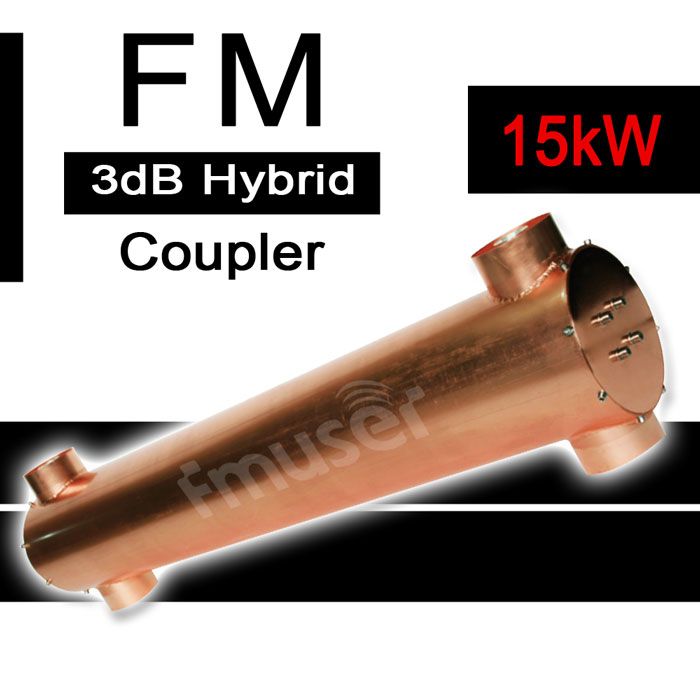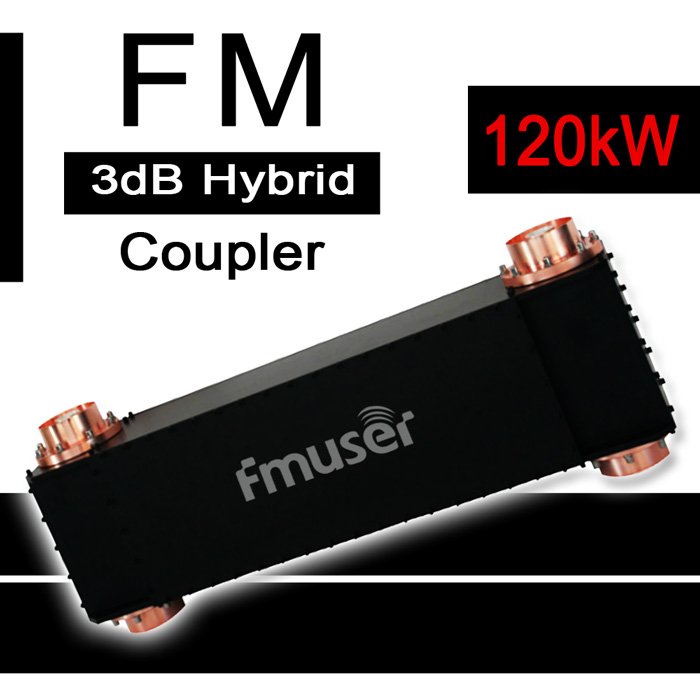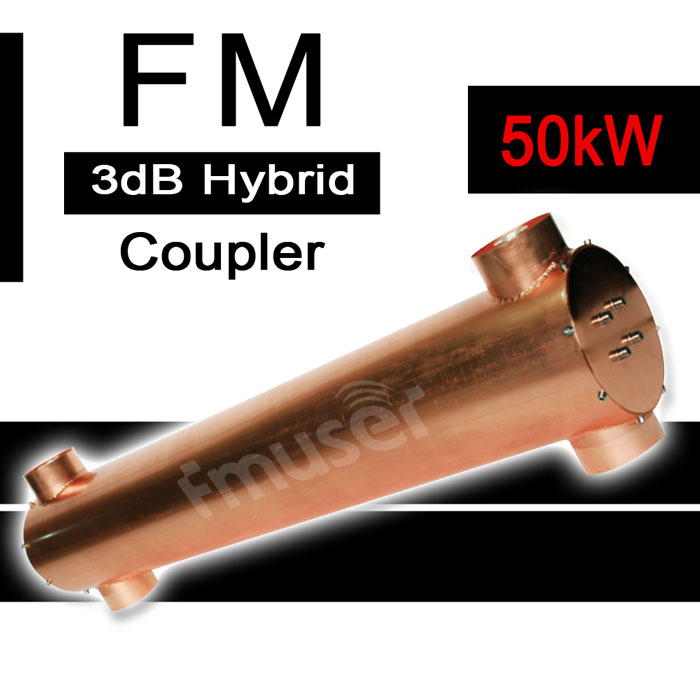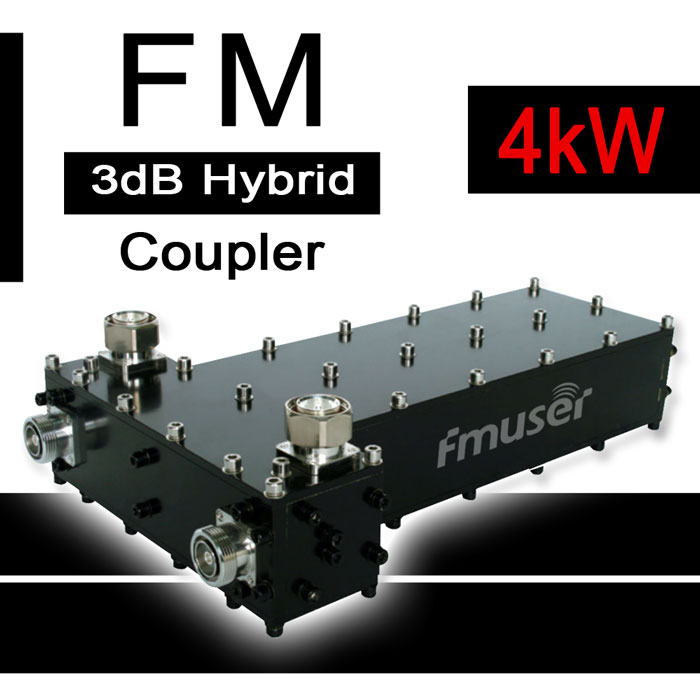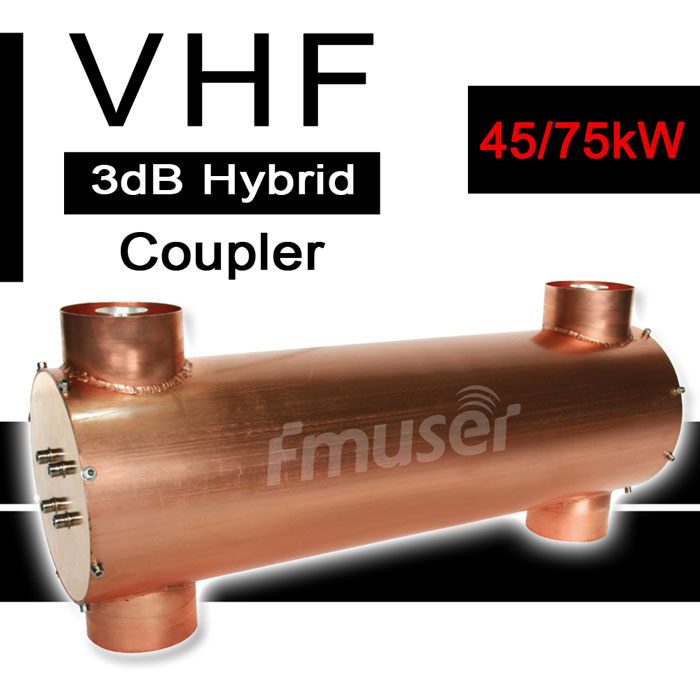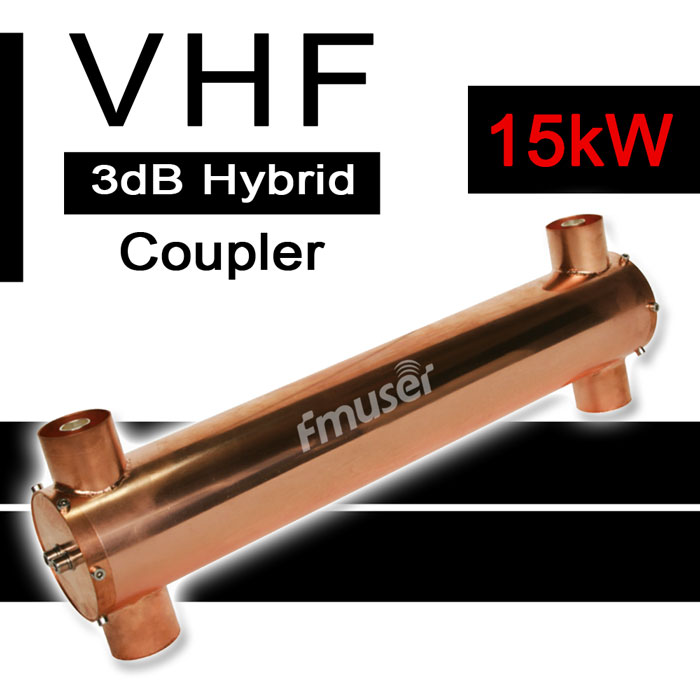
VHF Couplers
VHF hybrid couplers are mission-critical components for RF systems operating in the 30–300 MHz range, addressing challenges in signal distribution, antenna management, and impedance matching.
1. Mastering VHF Signal Control: FMUSER’s Hybrid Coupler Expertise
At FMUSER, we specialize in high-performance RF solutions tailored for broadcast, telecommunications, and defense industries. This page categorizes our couplers based on power capacity (5W–1000W+), frequency bands (VHF/UHF), and application-specific designs, empowering professionals to select precisely matched solutions for projects like multi-antenna arrays, signal routing networks, or impedance optimization.
2. Engineered for Excellence: Core Features of FMUSER’s VHF Hybrid Couplers
- Robust Durability: Military-grade materials ensure longevity in harsh environments.
- Ultra-Low Loss: ≤0.3 dB insertion loss maximizes signal integrity.
- Broadband Performance: Seamless operation across 88–108 MHz (FM broadcast) and 174–230 MHz (TV/communication).
- Certified Quality: ISO 9001-compliant manufacturing with EMI/RFI shielding.
- Scalable Solutions: From 5W compact couplers for hobbyists to 1000W industrial-grade systems for broadcast towers.
3. Powering Innovation: Applications of FMUSER’s VHF Hybrid Couplers
- Antenna Combining/Splitting: Enable multi-antenna setups without signal degradation using our phase-coherent couplers, ideal for broadcasters expanding coverage.
- Signal Distribution Networks: Split VHF signals to multiple receivers (e.g., radio stations, emergency systems) with ≤0.5 dB amplitude imbalance for uniform output.
- Impedance Matching: Minimize reflections in tower-mounted amplifiers (TMAs) using our 50Ω/75Ω hybrid couplers, reducing SWR to ≤1.2:1.
- Redundant System Design: Deploy fail-safe RF architectures for mission-critical communications, leveraging our high-isolation (≥20 dB) couplers.
4. Why FMUSER? Your Partner in RF Excellence
- Cost-Effective Direct Pricing: Save 20–30% with factory-direct rates.
- Always In Stock: 100+ couplers ready for 48-hour global shipping.
- Tailored Solutions: Custom modifications (OEM) for unique frequency/power needs.
- Turnkey Support: Pre-configuration, on-site installation, and lifetime technical backing.
- Proven Track Record: Trusted by Al Jazeera, BBC, and NATO-linked contractors.
5. Smart Buying Guide: Match Your Needs to FMUSER’s Solutions
- ✅ Power Handling: 5W (portable) vs. 1000W+ (broadcast).
- ✅ Frequency Range: Ensure compatibility with your VHF/UHF band.
- ✅ Interface Types: N-type, BNC, or DIN connectors.
- ✅ Budget vs. ROI: Balance upfront costs against long-term reliability.
-
![87-108MHz 15kW 1 5/8" FM Hybrid Coupler 4 Port VHF Stripline Coupler 3dB Hybrid Coupler High Power RF Splitter for FM Station]()
Price(USD):Ask for a quotation
Sold:17
-
![87-108MHz 120kW 4 1/2" 4 7/8" 6 1/8" FM Hybrid Coupler RF Splitter Combiner High Power RF Coupler RX TX Combiner for FM Station]()
Price(USD):Ask for a quotation
Sold:34
-
![87-108MHz 50kW 3 1/8" FM Coupler Combiner RF Transmitter Hybrid Splitter Combiner TX RX Stripline Power Divider for FM Broadcast]()
Price(USD):Ask for a quotation
Sold:34
-
![87-108 MHz 4kW 7-16 DIN FM Hybrid Coupler FM TX Stripline Coupler for VHF Combiner Multicoupler System]()
Price(USD):Ask for a quotation
Sold:17
-
![167-223 MHz 45kW 75kW 3 1/8" 4 1/2" VHF Passive RF Splitter Stripline 3dB Hybrid Combiner Coax RF Hybrid coupler for TV Station]()
Price(USD):Ask for a quotation
Sold:17
-
![167-223 MHz 15kW 1 5/8" VHF 3dB Hybrid Coupler Compact 4 Port Stripline Coupler High Power RF Hybrid Combiner for TV Station]()
Price(USD):Ask for a quotation
Sold:17
- What is a VHF hybrid coupler, and what is its synonym?
- A VHF hybrid coupler is an electrical component used to combine or split signals in a VHF (very high frequency) circuit. Its synonym is a diplexer.
- How do you use a VHF hybrid coupler for broadcasting?
- Steps:
1. Position the VHF hybrid coupler at the transmitter output of the broadcast station.
2. Connect the antenna port of the VHF hybrid coupler to the antenna.
3. Connect the transmitter port of the VHF hybrid coupler to the transmitter.
4. Adjust the power level of the transmitter to the desired power level.
5. Monitor the VSWR of the antenna and make adjustments as necessary.
Problems to Avoid:
1. Avoid any mismatch between the VHF hybrid coupler and the antenna, as this can cause signal distortion or even damage to the hybrid coupler.
2. Make sure that the VHF hybrid coupler is not exposed to direct sunlight or extreme temperatures.
3. Do not place the VHF hybrid coupler too close to any other equipment, as this can cause interference.
4. Avoid creating any sparks near the VHF hybrid coupler, as this can cause damage.
- How does a VHF hybrid coupler work?
- A VHF hybrid coupler is used in broadcast station to split the signal from one antenna into two different outputs, allowing one antenna to feed two transmitters. It works by combining the signals from the antennas into one signal and then splitting the combined signal into two signals, each with equal power. This allows the two transmitters to work simultaneously without interfering with each other.
- Why is a VHF hybrid coupler important for a radio station?
- A VHF hybrid coupler is an important part of a broadcast station because it allows for the transmission and reception of signals over the VHF frequency band. By coupling the transmitter and receiver together, the hybrid coupler ensures that the transmitted signal is received as intended. This is especially important for stations broadcasting audio or video content, as clear transmission of the signal is essential for proper playback. Without a hybrid coupler, stations would be unable to use the VHF frequencies and would be limited to using frequencies outside of the VHF band.
- How many types of VHF hybrid couplers are there and what are the differences between them?
- There are three different types of VHF hybrid couplers: directional couplers, hybrid couplers, and power dividers. Directional couplers are used to measure the forward and reverse power levels from a single antenna, while hybrid couplers are used to combine two signals to obtain maximum power. Power dividers are used to split a single signal into two or more equal power outputs. The main difference between the different types is their frequency range and power handling capability.
- How do you choose the best VHF hybrid coupler?
- When choosing the best VHF hybrid coupler for a broadcast station, it is important to consider the following factors: power output, directivity, insertion loss, isolation, noise figure, and return loss. Additionally, it is important to consider the size and weight of the device as well as the price. Researching different brands and models to compare these factors can help you find the best option for your needs. Make sure to read reviews and contact customer service for more information before placing your final order.
- How do you correctly connect a VHF hybrid coupler into the broadcast system?
- To correctly connect a VHF hybrid coupler in a broadcast station, you will need to follow the manufacturer's instructions. Generally, you will need to connect the antenna to the RF port on the coupler, then connect the power supply to the coupler. The output from the coupler will then need to be connected to the transmitter. Finally, you will need to adjust the hybrid coupler's power setting for the desired signal output.
- What equipment is related to a VHF hybrid coupler?
- The equipment related to a VHF hybrid coupler in a broadcast station typically includes an amplifier, an antenna, a filter, a directional coupler, a combiner, and a power supply.
- What are the most important physical and RF specifications of a VHF hybrid coupler?
- The most important physical and RF specifications of a VHF hybrid coupler include:
- Frequency Range: Typically operates between 100 MHz and 500 MHz
- Insertion Loss: Low insertion loss resulting in minimal power loss
- Isolation: High isolation between ports to prevent interference
- VSWR: Low VSWR to ensure maximum power transfer across ports
- Return Loss: High return loss to minimize reflected power
- Power Handling: Robust power handling capability to ensure efficient operation
- Temperature Range: Wide temperature range to ensure reliable operation in extreme temperatures
- Size: Compact size for easy installation.
- How do you correctly maintain a VHF hybrid coupler as an engineer?
- The correct procedure for daily maintenance of a VHF hybrid coupler in a broadcast station will depend on the specific model and manufacturer. Generally, the maintenance procedure should include visual inspection of the coupler, checking the power connection and antenna connections, checking the power output, and if necessary, making any necessary adjustments. Additionally, the coupler should be checked for possible faults, and any necessary repairs should be made.
- How do you repair a VHF hybrid coupler if it is not working?
- To repair a VHF hybrid coupler, first you will need to identify the broken part. If the coupler is no longer functioning, you can open it up and inspect the components to determine which parts are broken. Depending on the type of coupler, the repair process may vary. Some couplers may require the replacement of individual components, while other couplers may require an entire module to be replaced. Once the broken part is identified, you will need to source a replacement part, either from the manufacturer or from an electronics parts supplier. Once the new part is in hand, you can then follow the instructions in the user manual to replace the broken part and reassemble the coupler.
- How do you choose the right packaging for a VHF hybrid coupler?
- When choosing the right packaging for a VHF hybrid coupler, you should consider the size, shape, and weight of the device, as well as the type of material that will be used for the packaging. It is important to ensure that the packaging is designed to protect the device from any external damage during shipping and transportation. Additionally, the packaging should provide sufficient cushioning and support to keep the coupler from shifting around during transportation. Pay attention to the insulation and waterproofing of the packaging, if required. When transporting the VHF hybrid coupler, it is important to handle it carefully and to ensure that the package is labeled properly, so that it is not exposed to any unnecessary damage, moisture, or extreme temperatures.
- What material is used for the casing of a VHF hybrid coupler?
- The casing of a VHF hybrid coupler is generally made of metal, typically aluminum or steel. This material will not affect the performance of the coupler itself, but it may affect the overall performance of the system by blocking or interfering with the signal transmission.
- What is the basic structure of a VHF hybrid coupler?
- The basic structure of a VHF hybrid coupler consists of four ports: two input ports, two output ports, and a common port. The two input ports are used to receive signals from the two radio transmitters, while the two output ports are used to send the combined signals to the radio receivers. The common port is used to couple the signals from the two input ports and send the combined signals to the two output ports. The structure of the hybrid coupler determines its attributes and performance, and it cannot work normally without any of the structures.
- Who should be assigned to operate a VHF hybrid coupler?
- The person who should be assigned to manage a VHF hybrid coupler should be a highly experienced broadcast engineer. This person should possess a thorough understanding of broadcast systems, particularly VHF systems, and have a strong technical background in electronics, networking, and radio communication. Additionally, they should have a good working knowledge of the various components of a hybrid coupler, including amplifiers, filters, and other related parts, and have the ability to troubleshoot any potential problems that may arise.
- How are you?
- I am fine
CONTACT US


FMUSER INTERNATIONAL GROUP LIMITED.
We are always providing our customers with reliable products and considerate services.
If you would like to keep touch with us directly, please go to contact us
